Citroen C5 2007.5 (DC/DE) / 1.G Manual PDF
Manufacturer: CITROEN, Model Year: 2007.5, Model line: C5, Model: Citroen C5 2007.5 (DC/DE) / 1.GPages: 231, PDF Size: 7.63 MB
Page 71 of 231
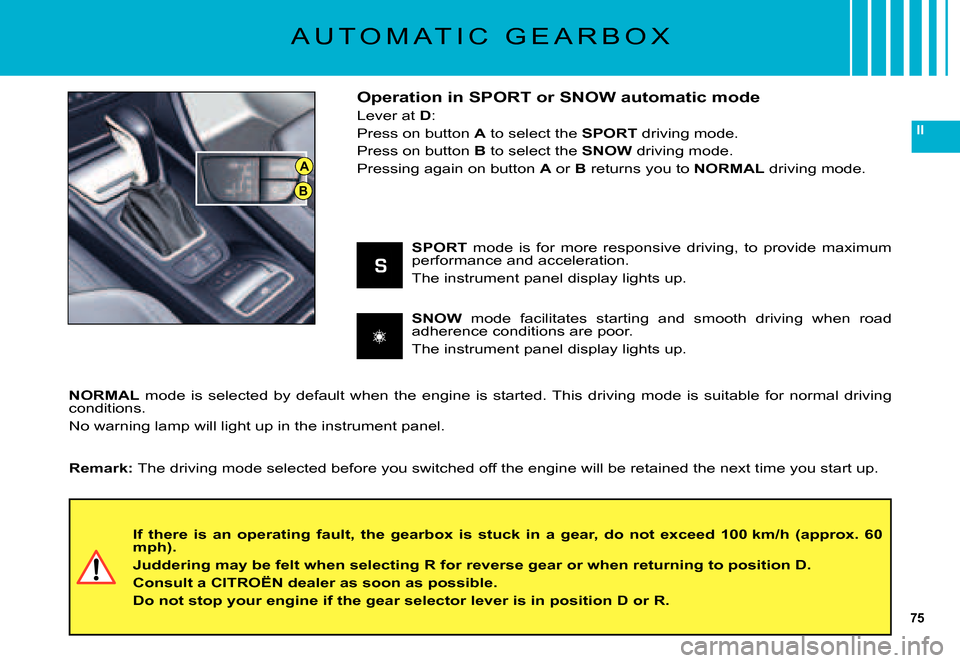
75
II
A
B
A U T O M A T I C G E A R B O X
Operation in SPORT or SNOW automatic mode
Lever at D:
Press on button A to select the SPORT driving mode.
Press on button B to select the SNOW driving mode.
Pressing again on button A or B returns you to NORMAL driving mode.
NORMAL mode is selected by default when the engine is started. This driving mode is suitable for normal driving conditions.
No warning lamp will light up in the instrument panel.
SNOW mode facilitates starting and smooth driving when road adherence conditions are poor.
The instrument panel display lights up.
SPORT mode is for more responsive driving, to provide maximum performance and acceleration.
The instrument panel display lights up.
Remark: The driving mode selected before you switched off the engin e will be retained the next time you start up.
If there is an operating fault, the gearbox is stuck in a gear, do not exceed 100 km/h (approx. 60 mph).
Juddering may be felt when selecting R for reverse gear or when returning to position D.
Consult a CITROËN dealer as soon as possible.
Do not stop your engine if the gear selector lever is in position D or R.
Page 72 of 231
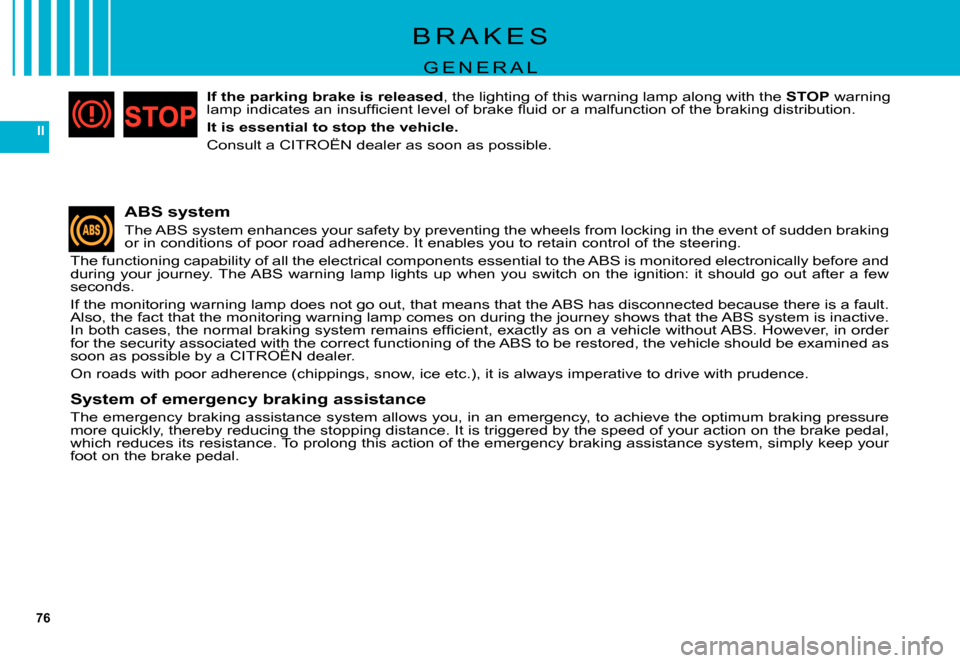
76
II
B R A K E S
G E N E R A L
ABS system
The ABS system enhances your safety by preventing the wheels from locking in the event of sudden braking or in conditions of poor road adherence. It enables you to retain control of the steering.
The functioning capability of all the electrical components essential to the ABS is monitored electronically before and during your journey. The ABS warning lamp lights up when you sw itch on the ignition: it should go out after a few seconds.
If the monitoring warning lamp does not go out, that means that the ABS has disconnected because there is a fault. Also, the fact that the monitoring warning lamp comes on durin g the journey shows that the ABS system is inactive. �I�n� �b�o�t�h� �c�a�s�e�s�,� �t�h�e� �n�o�r�m�a�l� �b�r�a�k�i�n�g� �s�y�s�t�e�m� �r�e�m�a�i�n�s� �e�f�fi� �c�i�e�n�t�,� �e�x�a�c�t�l�y� �a �s� �o�n� �a� �v�e�h�i�c�l�e� �w�i�t�h�o�u�t� �A�B�S�.� �H�o�w�e�v�e�r�,� �i�n� �o�r�d�e�r� for the security associated with the correct functioning of the ABS to be restored, the vehicle should be examined as soon as possible by a CITROËN dealer.for the security associated with the correct associated with the
On roads with poor adherence (chippings, snow, ice etc.), it is always imperative to drive with prudence.
System of emergency braking assistance
The emergency braking assistance system allows you, in an emergency, t o achieve the optimum braking pressure more quickly, thereby reducing the stopping distance. It is triggered by the speed of your action on the brake pedal, which reduces its resistance. To prolong this action of the emerg ency braking assistance system, simply keep your foot on the brake pedal.
If the parking brake is released, the lighting of this warning lamp along with the STOP warning �l�a�m�p� �i�n�d�i�c�a�t�e�s� �a�n� �i�n�s�u�f�fi� �c�i�e�n�t� �l�e�v�e�l� �o�f� �b�r�a�k�e� �fl� �u�i�d� �o�r� �a� �m�a�l�f�u�n�c�t�i�o�n� �o�f� �t�h�e� �b�r�a�k�i�n�g� �d�i�s�t�r�i�b�u�t�i�o�n�.
It is essential to stop the vehicle.
Consult a CITROËN dealer as soon as possible.
Page 73 of 231

77
II
A
The electronic parking brake com-bines 2 operational modes:AUTOMATIC:
Automatic application when the engine is stopped and automatic release on use of the accelerator (automatic operation by default).
MANUAL:The MANUAL application/release of the parking brake is possible permanently by pull-ing/pushing control A.
Page 74 of 231
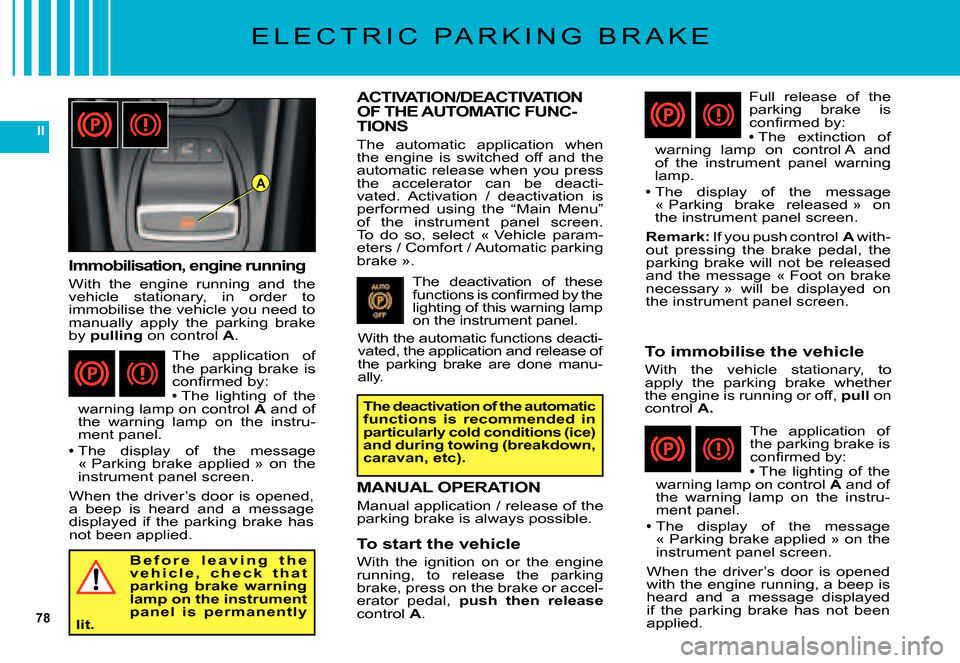
78
II
A
E L E C T R I C P A R K I N G B R A K E
ACTIVATION/DEACTIVATION OF THE AUTOMATIC FUNC-TIONS
The automatic application when the engine is switched off and the automatic release when you press the accelerator can be deacti-vated. Activation / deactivation is performed using the “Main Menu” of the instrument panel screen. To do so, select « Vehicle param-eters / Comfort / Automatic parking brake ».
The deactivation of these �f�u�n�c�t�i�o�n�s� �i�s� �c�o�n�fi� �r�m�e�d� �b�y� �t�h�e� lighting of this warning lamp on the instrument panel.
With the automatic functions deacti-vated, the application and release of the parking brake are done manu-ally.
MANUAL OPERATION
Manual application / release of the parking brake is always possible.
To start the vehicle
With the ignition on or the engine running, to release the parking brake, press on the brake or accel-erator pedal, push then releasecontrol A.
The application of the parking brake is �c�o�n�fi� �r�m�e�d� �b�y�:The lighting of the warning lamp on control A and of the warning lamp on the instru-ment panel.
The display of the message « Parking brake applied » on the instrument panel screen.
When the driver’s door is opened, a beep is heard and a message displayed if the parking brake has not been applied.
Page 75 of 231

79
II
E L E C T R I C P A R K I N G B R A K E
S P E C I A L F E A T U R E S
MAXIMUM APPLICATION
If necessary, you can utilise maximum application of the parking brake. It is obtained by means of a long pull on control A, until you see the message « Maximum parking brake application » and a beep is heard.
Maximum application is indispensable:In the case of a vehicle towing a caravan or a trailer, if the automatic functions are activated but you are applying the parking brake manually.
When the gradient you are parked on is variable in its effect (e.g. on a ferry, in a lorry, during towing).Note:In the case of towing, a loaded vehicle or parking on a gradient, turn the front wheels towards the pavement and engage a gear when you park.
After maximum application, the release time will be longer.
PARTICULAR SITUATIONS
In certain situations (starting the engine, etc), the parking brake can automatically alter its force. This is normal opera-tion.
To advance your vehicle a few centimetres without starting the engine, but with the ignition on, press on the brake pedal and release the parking brake by pushing then releasing control A.
�T�h�e� �f�u�l�l� �r�e�l�e�a�s�e� �o�f� �t�h�e� �p�a�r�k�i�n�g� �b�r�a�k�e� �i�s� �c�o�n�fi� �r�m�e�d� �b�y� �t�h�e� �e�x�t�i�n�c�t�i�o�n� �o�f� �t�h�e� �w�a�r�n�i�n�g� �l�a�m�p� �o�n� �c�o�n�t�r�o�l� A, and of the warn-ing lamp on the instrument panel, and by the display of the message « Parking brake released » on the instrument panel screen.
If the parking brake malfunctions while applied� �o�r� �i�f� �t�h�e� �b�a�t�t�e�r�y� �r�u�n�s� �fl� �a�t�,� �a�n� �e�m�e�r�g�e�n�c�y� �r�e�l�e�a�s�e� �i�s� �a�l�w�a�y�s� �p�o�s�s�i�b �l�e� (see paragraph « Emergency unlocking »).
Page 76 of 231
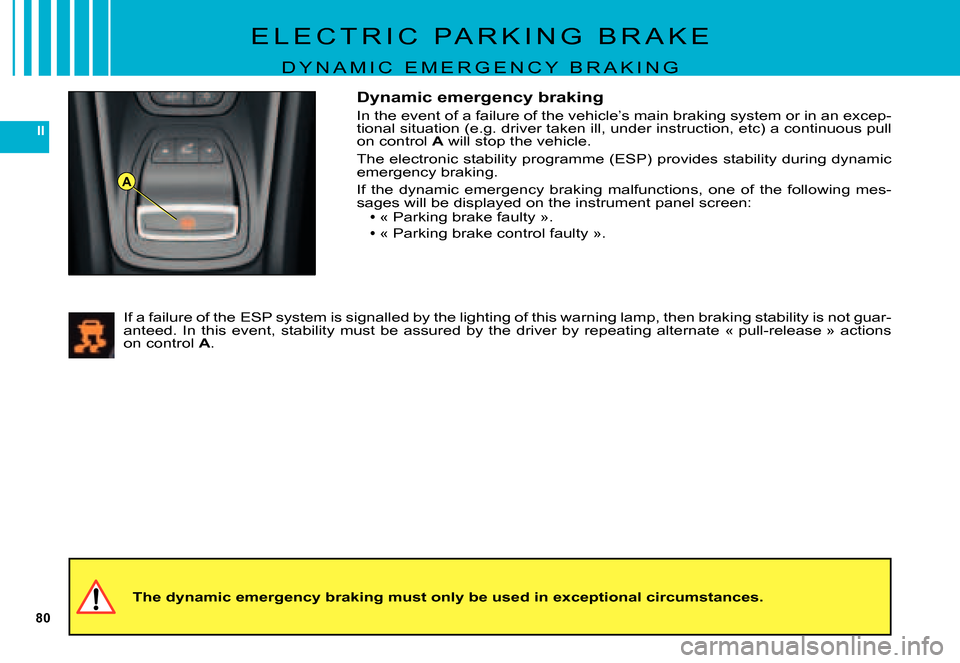
80
II
A
E L E C T R I C P A R K I N G B R A K E
D Y N A M I C E M E R G E N C Y B R A K I N G
Dynamic emergency braking
In the event of a failure of the vehicle’s main braking system or in an excep-tional situation (e.g. driver taken ill, under instruction, etc) a continuous pull on control A will stop the vehicle.
The electronic stability programme (ESP) provides stability during dynami c emergency braking.
If the dynamic emergency braking malfunctions, one of the following mes-sages will be displayed on the instrument panel screen:« Parking brake faulty ».
« Parking brake control faulty ».
Page 77 of 231
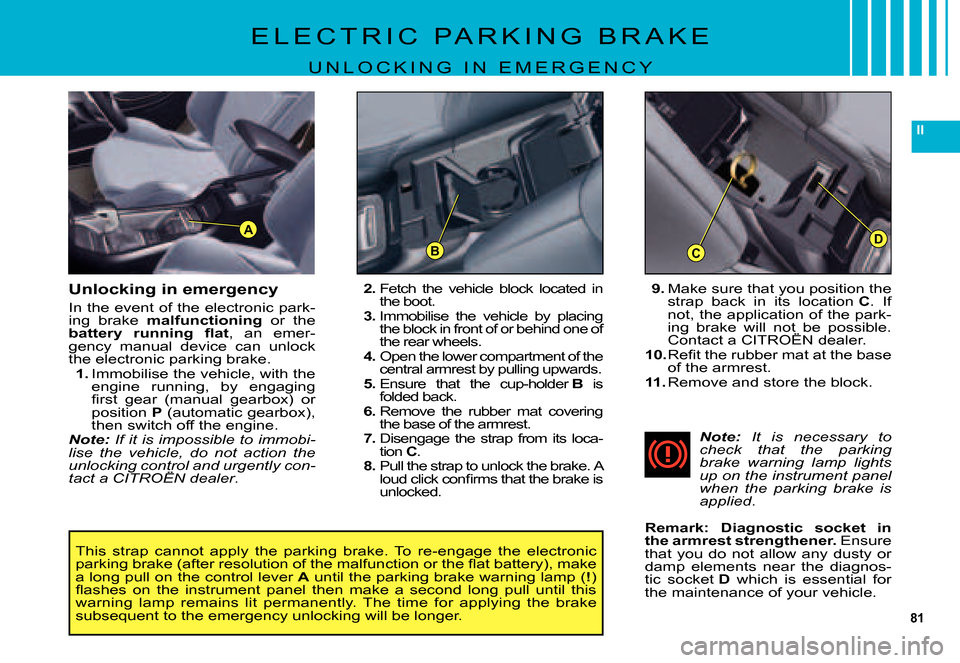
81
II
DCB
A
Unlocking in emergency
In the event of the electronic park-ing brake malfunctioning or the �b�a�t�t�e�r�y� �r�u�n�n�i�n�g� �fl� �a�t, an emer-gency manual device can unlock the electronic parking brake.1. Immobilise the vehicle, with the engine running, by engaging �fi� �r�s�t� �g�e�a�r� �(�m�a�n�u�a�l� �g�e�a�r�b�o�x�)� �o�r� position P (automatic gearbox), then switch off the engine.Note: If it is impossible to immobi-lise the vehicle, do not action the unlocking control and urgently con-tact a CITROËN dealerunlocking control and urgently control .
E L E C T R I C P A R K I N G B R A K E
U N L O C K I N G I N E M E R G E N C Y
9. Make sure that you position the strap back in its location C. If not, the application of the park-ing brake will not be possible. Contact a CITROËN dealer.ing brake will not be possible. will not be
10. �R�e�fi� �t� �t�h�e� �r�u�b�b�e�r� �m�a�t� �a�t� �t�h�e� �b�a�s�e� of the armrest.11. Remove and store the block.
This strap cannot apply the parking brake. To re-engage the electronic �p�a�r�k�i�n�g� �b�r�a�k�e� �(�a�f�t�e�r� �r�e�s�o�l�u�t�i�o�n� �o�f� �t�h�e� �m�a�l�f�u�n�c�t�i�o�n� �o�r� �t�h�e� �fl� �a�t � �b�a�t�t�e�r�y�)�,� �m�a�k�e� a long pull on the control lever A until the parking brake warning lamp (!) �fl� �a�s�h�e�s� �o�n� �t�h�e� �i�n�s�t�r�u�m�e�n�t� �p�a�n�e�l� �t�h�e�n� �m�a�k�e� �a� �s�e�c�o�n�d� �l�o�n�g� �p�u�l�l� �u�n�t�i�l� �t�h�i�s� warning lamp remains lit permanently. The time for applying the brake subsequent to the emergency unlocking will be longer.
2. Fetch the vehicle block located in the boot.3. Immobilise the vehicle by placing the block in front of or behind one of the rear wheels.4. Open the lower compartment of the central armrest by pulling upwards.5. Ensure that the cup-holder B is Bfolded back.6. Remove the rubber mat covering the base of the armrest.7. Disengage the strap from its loca-tion C.8. Pull the strap to unlock the brake. A �l�o�u�d� �c�l�i�c�k� �c�o�n�fi� �r�m�s� �t�h�a�t� �t�h�e� �b�r�a�k�e� �i�s� unlocked.
Note: It is necessary to check that the parking brake warning lamp lights up on the instrument panel when the parking brake is applied.
Remark: Diagnostic socket in the armrest strengthener. Ensure that you do not allow any dusty or damp elements near the diagnos-tic socket D which is essential for the maintenance of your vehicle.
Page 78 of 231
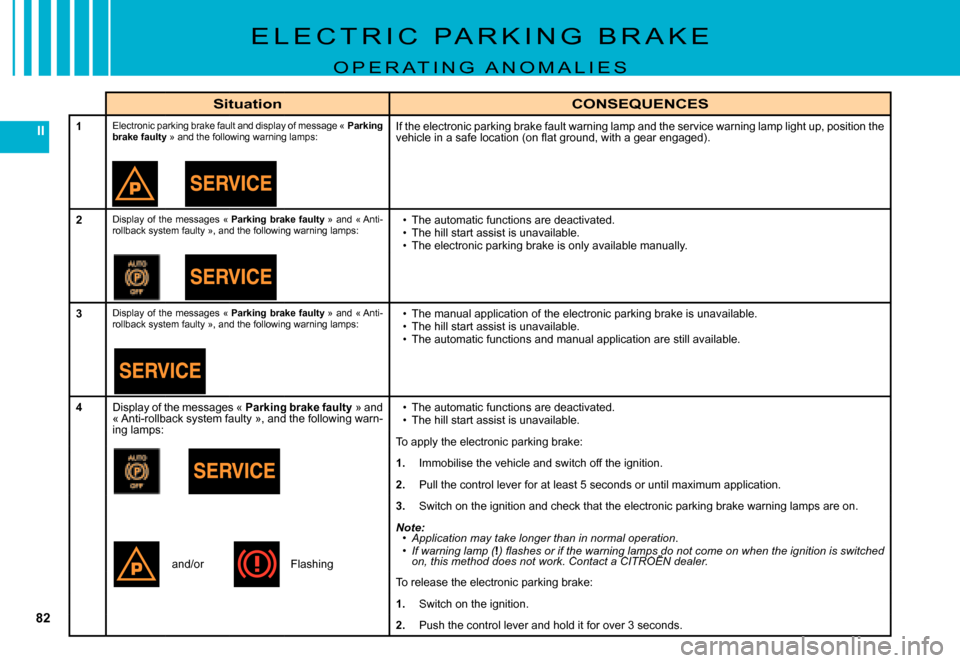
82
II
E L E C T R I C P A R K I N G B R A K E
O P E R A T I N G A N O M A L I E S
SituationCONSEQUENCES
1Electronic parking brake fault and display of message « Parking brake faulty » and the following warning lamps:If the electronic parking brake fault warning lamp and the service warning lamp light up, position the �v�e�h�i�c�l�e� �i�n� �a� �s�a�f�e� �l�o�c�a�t�i�o�n� �(�o�n� �fl� �a�t� �g�r�o�u�n�d�,� �w�i�t�h� �a� �g�e�a�r� �e�n�g�a�g�e�d�)�.
2Display of the messages « Parking brake faulty » and « Anti-rollback system faulty », and the following warning lamps:The automatic functions are deactivated.The hill start assist is unavailable.The electronic parking brake is only available manually.
Page 79 of 231

83
II
If any of these instances arises, contact a CITROËN dealer as soon as possible.
E L E C T R I C P A R K I N G B R A K E
O P E R A T I N G A N O M A L I E S
SITUATIONCONSEQUENCES
5Display of message « Parking brake control faulty – automatic mode activated » and the following warning lamps:
Only the functions for automatic application on switching off the engine and automatic release on acceleration are available.MANUAL application/release of the electronic parking brake and d ynamic emergency braking are unavailable.
Page 80 of 231
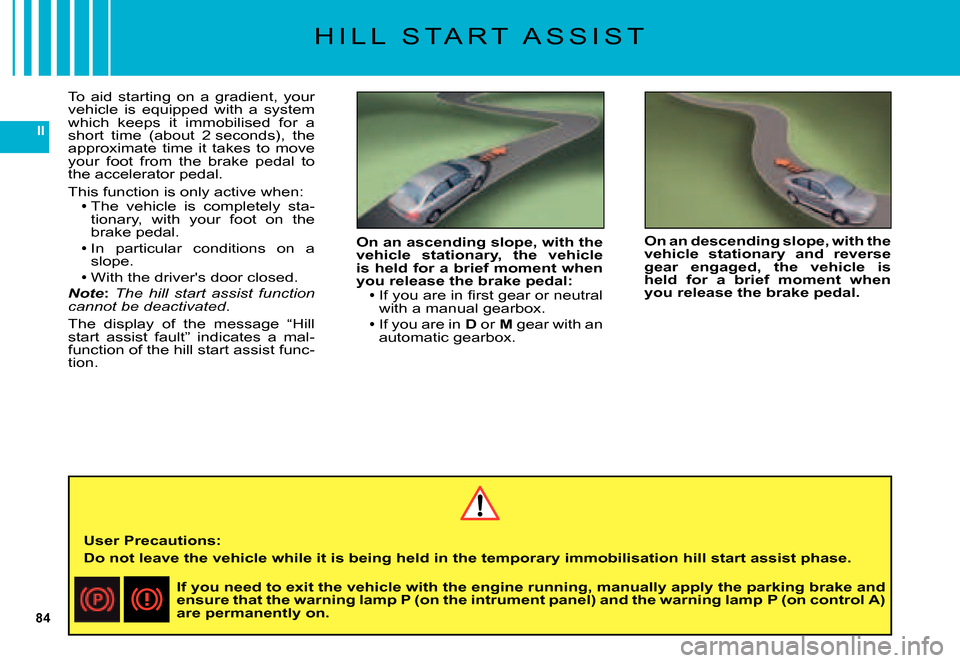
84
II
H I L L S T A R T A S S I S T
To aid starting on a gradient, your vehicle is equipped with a system which keeps it immobilised for a short time (about 2 seconds), the approximate time it takes to move your foot from the brake pedal to the accelerator pedal.
This function is only active when:The vehicle is completely sta-tionary, with your foot on the brake pedal.
In particular conditions on a slope.With the driver's door closed.Note:The hill start assist function cannot be deactivated.
The display of the message “Hill start assist fault” indicates a mal-function of the hill start assist func-tion.